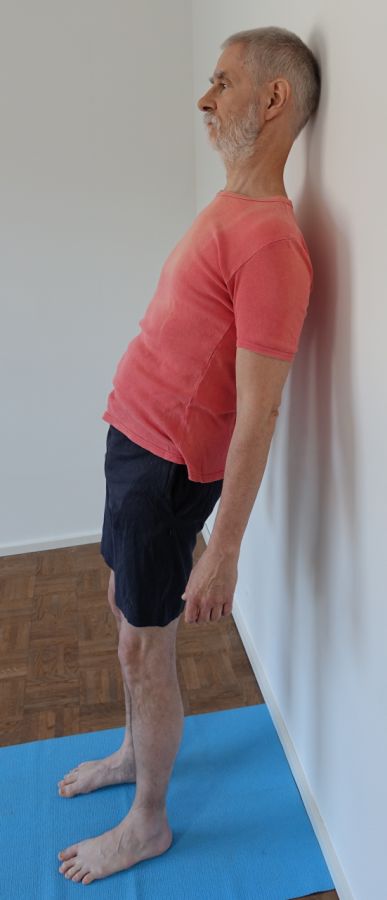yogabook / functional exercises / press your head on the wall
Contents
„press your head on the wall“

 instructions and details with working links as PDF for download/print
instructions and details with working links as PDF for download/print
Feedback: We’d love to hear what you think about this description, give us feedback at:
postmeister@yogabook.org
last update: 10.8.2021
Name:
Trivia name: Press your head on the wall
Level: A
- Classification: A
- Contraindication
- Effects of
- Preparation
- follow-up
- derived asanas
- similar asanas
- diagnostics
- Instruction
- details
- Variants
Classification
classic: functional exercise
psychomental:
physiological: stretching (neck)
Contraindication
Effects
- (207) Neck/spine: reclination force
- (622) Strength of the neck / cervical spine
Instructions
- Stand with your back to a wall at a distance of 10 cm.
- Lean your buttocks and back against the wall.
- Press your head against the wall and begin to move your buttocks and back further and further away from the wall as you feel comfortable.
- If the intensity is not sufficient at the current distance of the feet from the wall, increase it until sufficient intensity is possible. However, bring your bottom and back against the wall again.
- Once a distance has been found that seems appropriate for the load capacity of the neck, the intensity can be fine-tuned via the distance of the pelvis from the wall: a greater distance intensifies the requirement, a smaller distance softens it.
Details
- This functional exercise is intended for cases in which it is not possible to perform the exercise in the supine position, such as pressing the head to the floor. Reasons why the exercise cannot be performed may include
- The force used should be increased slowly and any limitations of the neck muscles should be taken into account. In the case of neck tension, even a moderate application of force can trigger a clear sensation in the muscles. As the neck muscles work in a fairly neutral angle range here, the muscular work will not lead to an increase in tone but rather to a reduction in hypertonus.
- The shoulder blades move towards the pelvis and the spine.
- You can exert enough force to lift the upper back if this is OK for the neck muscles. If there is uncomfortable pressure at the point of contact at the back of the head, a blanket can help to soften it.
- To intensify the exercise, the arms can also be folded across the chest instead of lying at the side of the body.
- It should be possible to perform this posture with at least a moderate amount of force, even if there is known damage to the cervical spine. However, the advice of the treating therapist should be sought before attempting more vigorous exercises.
- In addition to the muscles in the neck area, a slight strain may also be felt in the area of the autochthonous back muscles further caudally.
- Depending on the nature of the wall and individual sensitivity to pressure, the back of the head can be placed on the wall using a softening agent. Several patches are well suited for this, a blanket is also suitable.
- The neck should not be hyperlordotic, which means in particular that the head should not be positioned too low on the wall or too far cranially. A convex position of the neck should also be avoided. In rather rare cases, a steep position of the cervical spine is already contraindicated; this could be the case with facet syndrome, spinal canal stenosis or spondylolisthesis.
- If possible, avoid a hollow back in the lumbar spine.
- The aim is to keep the body in an anatomically zero-compliant extension as far as possible. As the distance between the heels and the wall increases, the point of the back of the head resting on the wall will move cranially.
- Both the distance of the feet from the wall and the distance of the pelvis from the wall can be increased for greater intensity. While the distance of the pelvis can be increased gradually, but only to a very limited extent, given the position of the feet, the distance of the feet from the wall offers a much better opportunity to increase the intensity. However, in order to change the distance between the feet, the posture should always be returned to the starting position with the buttocks and back against the wall, i.e. without any significant load on the cervical spine. If the pelvis is moved further away from the wall to fine-tune the intensity, care should be taken to avoid an uncomfortable hollow back, i.e. the pelvis should be tilted backwards at the top with the hip extensors in line with the increase in distance.
- This exercise can be used to „revitalise“ a stiffened neck in a neutral angle range and therefore very well tolerated, i.e. to gradually build up strength and also to increase the range of movement after an appropriate warm-up. This exercise can also, and especially in the case of pathological changes in the cervical spine area, serve well as a low-risk way of improving neck sutiation.
